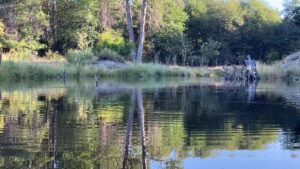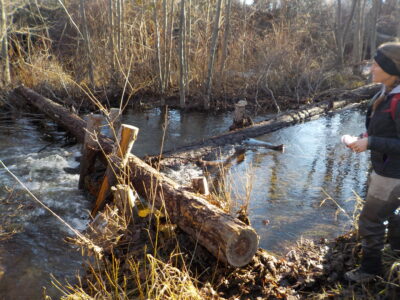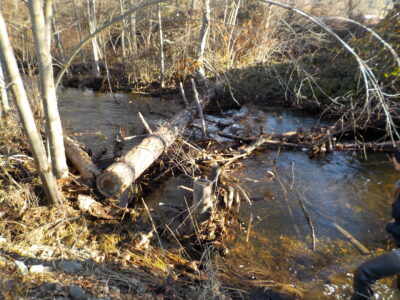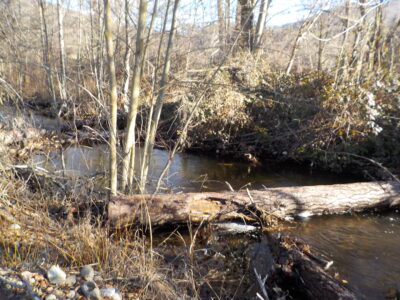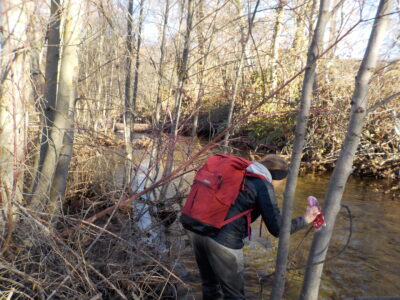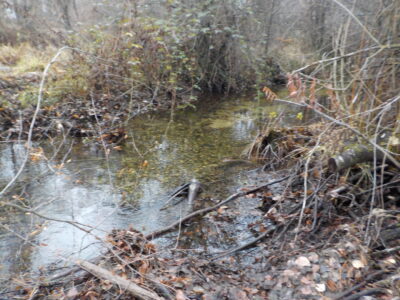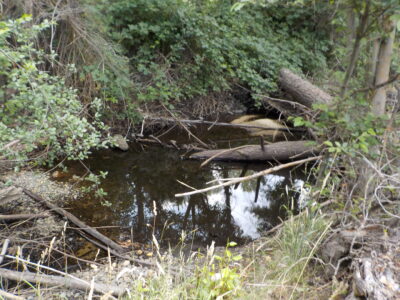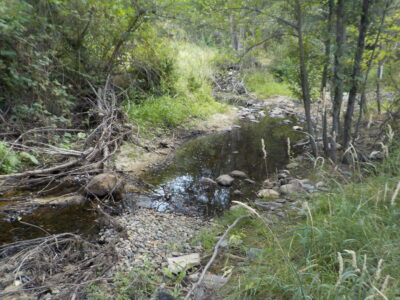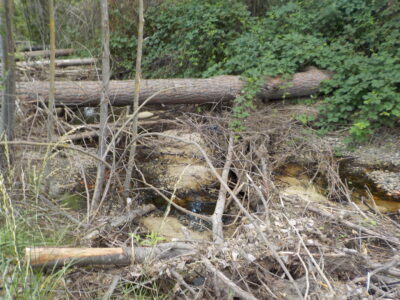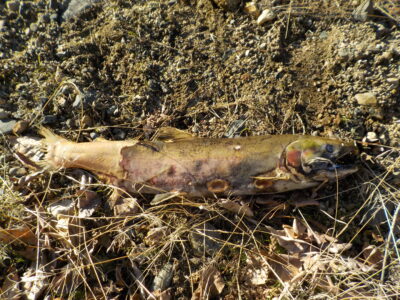The Scott River’s coho population is recognized by NOAA Fisheries as a core, independent population and is listed as threatened. In many years, the Scott River has the largest coho population estimates of any watershed in California. This makes large-scale restoration investments in the Scott watershed significant to coho recovery. Within the Scott, the only tributary with documented coho spawning and rearing every year for the past 20 years is French Creek, pointing to the value of restoring the Klamath’s “best of the best” stream. In recent surveys, mid-French Creek has the highest density of coho redds (fish egg nests) documented in the entire Scott River watershed. Coho spawning in French Creek has increased over time, most likely due to SRWC’s restoration efforts.
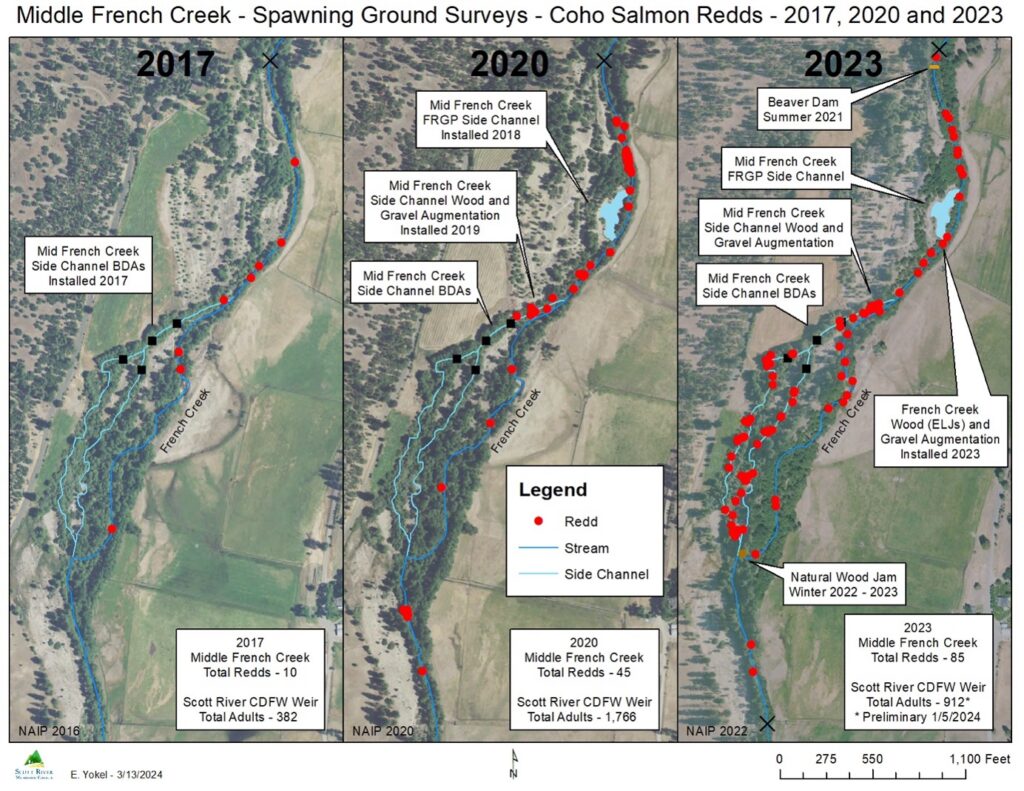
Despite the increasing coho production, and like much of the Scott watershed, French Creek suffers from the effects of gold mining, land development for agriculture, stream channelization, extensive beaver harvest, upslope road development, and agricultural water extraction all of which have significantly reduced the quality and quantity of the available habitat for spawning and rearing salmonids. These cumulative human impacts have fundamentally altered the stream’s channel form, floodplain connectivity, and ecological conditions for native wildlife. The channel is cut down, which disconnects the floodplain and steepens channel banks; this has led to reduced in-stream and floodplain habitat, native tree and shrubs, invasion of non-native blackberry, and simplification of primary and secondary channels with resulting groundwater storage. In addition, much of the right bank of French Creek in the Project reach is rip-wrapped with rock. The degraded floodplains inhibit cottonwood and willow from thriving and providing a sustainable food supply for beaver—who build and maintain coho habitat for free—and are likely a factor limiting beaver populations. The project reach currently supports a small, yet stable population of beaver, but the limited food and dam-building materials coupled with high flow velocities in the winter, due to channel simplification, restrict their expansion and subsequent habitat creation.
Due to the importance of French Creek and its degrading condition, SRWC and our many partners, have focused considerable restoration effort on the stream over the years.
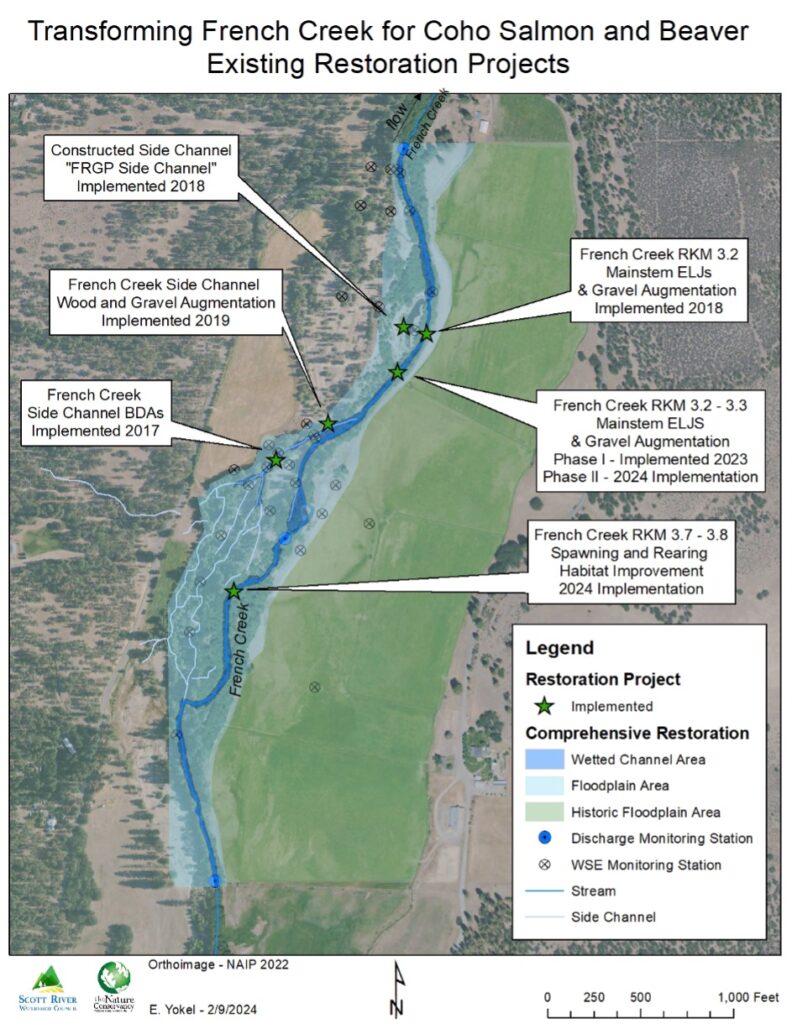
The first SRWC project in French Creek was installing 4 BDAs in a small side channel that had minimal salmonid utilization. At the time, SRWC was working closely with California Department of Fish and Wildlife (CDFW) and National Oceanic and Atmospheric Administration (NOAA) to perform a scientific study on California’s very first BDAs. The French Creek BDAs were built in this side channel to see if they would improve physical conditions and water quality sufficiently to attract salmon. Well…they did. On going monitoring by SRWC crews have shown consistent winter use by Coho with the juveniles growing bigger than those rearing elsewhere. Naturally caused changes in the stream have also increased flow into the side channel, further improving the habitat. This project was funded by USFWS.


Embracing a successful restoration technique piloted by the Karuk tribe and the Mid Klamath Watershed Council, SRWC constructed a side channel feature in French Creek in 2018. Differing from the Mid Klamath projects, which have single connection to the stream, the SRWC side channel is connected at the downstream and upstream ends, while also creating a pond. Included in the project was introduction of spawning gravel and some Engineered Log Jams (ELJs) in the main French Creek channel. The design of the project was significantly driven by regulatory and permitting considerations. The introduced gravel was used by coho salmon in the first spawning season after introduction and in many of the following years. Juvenile coho utilize the side channel for winter rearing every year and sometimes use it during the summer season. SRWC scientists identified poor spawning conditions as a limiting factor for coho production in French Creek, and the fish have responded to the SRWC addressing of this limiting factor by extensively using introduced spawning gravels everywhere they have placed. Many other species such as beaver, otter, minks, ducks, geese and a western pond turtle have been found in the pond. The project was funded by the CDFW Fisheries Restoration Grant Program.

Downstream from the BDAs, SRWC installed some unanchored wood in the naturally formed side channel, along with some spawning gravels. While no spawner use in the side channel was identified prior to restoration, they have used the side channel every year since 2019 when the side channel project was completed. Over time, the previously very simplified channel has developed pools and riffles from the introduction of wood. The project used bug killed trees from the landowner’s wood lot and placed and secured them by interweaving them into existing trees for stability. Willows were planted everywhere there was construction disturbance to provide wood for resident beavers. This project was funded by USFWS.
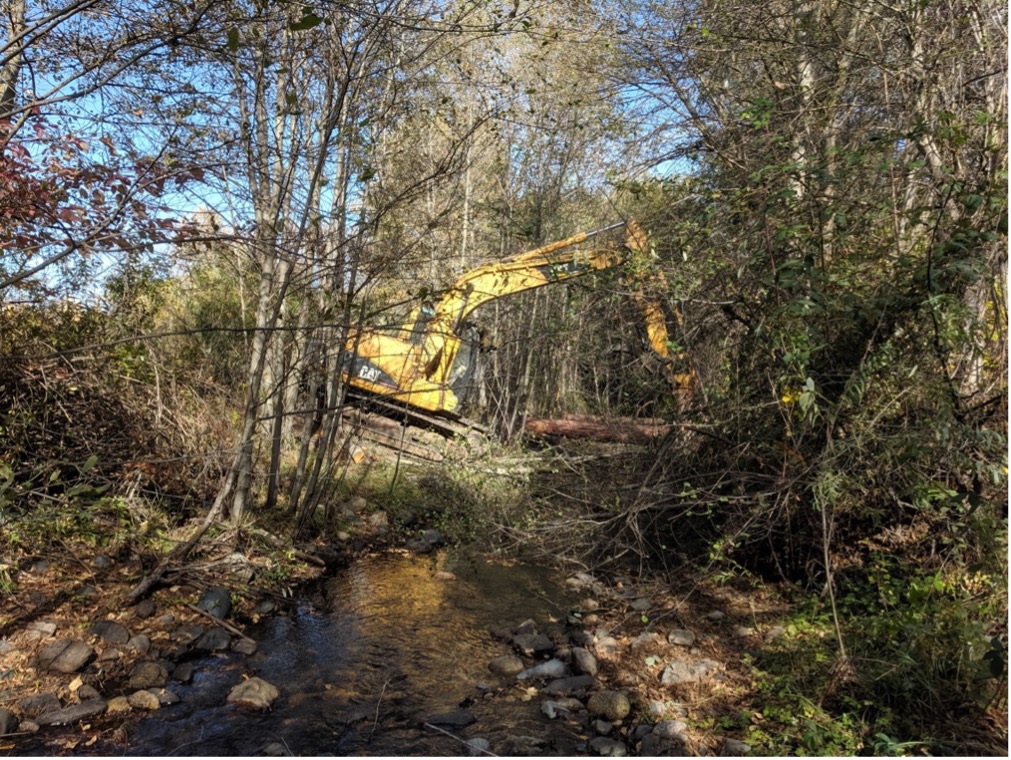
French Creek Wood and Gravel Project during construction in 2019.
The next restoration project in Mid French Creek was installed in 2023 and consisted of 5 large ELJs installed in the main French Creek channel upstream of the FRGP side channel. The purpose of these ELJs is to create more instream habitat by moving the straight simple channel at the location towards more pools and riffles, as well as providing cover for rearing fish under the logs. Oh course, more gravel was introduced. Spawning coho utilized the introduced gravel with several redds identified in the reach. In addition, both adult coho and beaver were seen resting in slow water behind the jams during high flow events in the winter of 2023-2024. This project was funded by the Bureau of Recreation with funds administered by the National Fish and Wildlife Foundation. More ELJs of this type are slated for construction in 2024.


All these projects occurred on a single landowner’s property, however, the 2023 purchase by The Nature Conservancy’s (TNC) of the ranch across the creek opens the door to large reach scale restoration of over a mile of French Creek’s invaluable habitat. Planning for this exciting project is underway with Quartz Valley Indian Reservation as the project lead with strong collaboration with SRWC and TNC.
Beavers occupied the stream before SRWC started any restoration and we
continually learn from them how to manage the ecological system and, in turn, are
always striving to ensure that our restoration efforts support their needs. Monitoring
has shown that the habitat behind beaver dams on French Creek offer excellent
rearing conditions for coho, however the dams are washed out every winter because
French Creek is confined in a down cut, narrow channel which concentrates its force.
We have pounded posts into the dams to reinforce them, which did not provide
sufficient structural integrity to allow them to withstand high winter flow. We are
hopeful that the planned, large-scale restoration which will remove rip-rap and allow
the stream more room to achieve a natural shape and function, will create conditions where the dams blow out only during extreme flood events. In the meantime, we are
planting willow and cottonwood, preferred beaver food sources, so that our beaver
restoration partners have plenty to eat and materials with which to build dams.
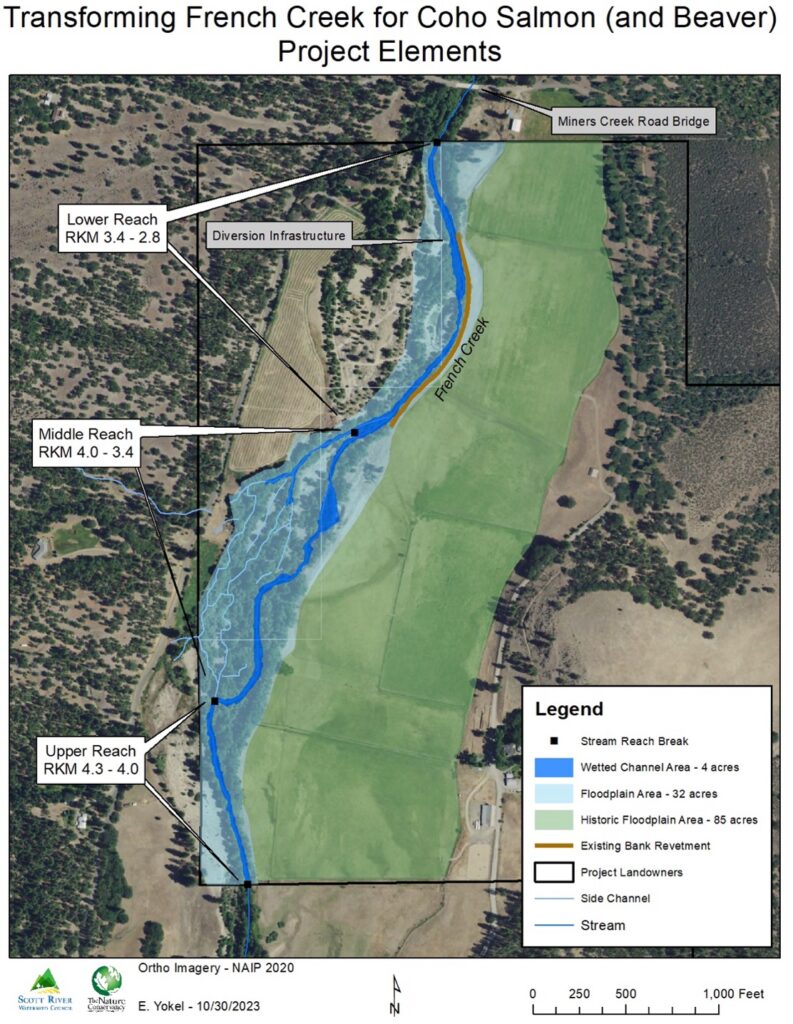
Read More on French Creek Wood & Gravel Enhancement
| Funder | Contract # | Start Date | End Date | Funding Source | Land Ownership | Award Amount |
| NFWD/BOR | 0208.22.075220 | 12/1/2022 | 6/30/2025 | Federal | Private | $189,316 |
